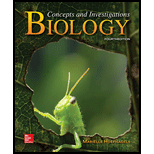
Concept explainers
A prokaryotic cell is one that
- a. lacks DNA.
- b. has membrane-bounded organelles.
- c. lacks a nucleus.
- d. lacks a plasma membrane.
Introduction:
A prokaryotic cell is a primitive cell with unbound organelles and genetic material. It makes up the two of the three domains which are Bacteria and Archaea. They have less organelles and lesser specializations.
Answer to Problem 1MCQ
Correct answer:
A prokaryotic cell lacks the nucleus. Therefore, option c. is correct.
Explanation of Solution
Reason for the correct statement:
The prokaryotes have a single DNA strand, lacking histones and even a membrane. The DNA is just present in the cytoplasm like other organelles. It is called a nucleoid. The proper double membrane bound nucleus found in eukaryotes is missing in prokaryotes.
Option c. is given as “lacks a nucleus”.
As, “a prokaryotic cell is one that lacks a nucleus”, is the right answer.
Hence, the option c. is correct.
Reasons for the incorrect statements:
Option a. is given as “lacks DNA”.
DNA is the carrier of all the hereditary information. It is present in all the organisms. So, it is a wrong answer.
Option b. is given as “has membrane-bounded organelles”.
A prokaryotic cell does not have any membrane bound organelles. So, it is a wrong answer.
Option d. is given as “lacks a plasma membrane”.
Plasma membrane encloses the cytoplasm of a cell. It is present in all the cells. So, it is a wrong answer.
Hence, options a., b. and d. are incorrect.
One very distinctive feature between eukaryotes and prokaryotes is the presence and absence of nucleus, respectively.
Want to see more full solutions like this?
Chapter 17 Solutions
Biology: Concepts and Investigations
Additional Science Textbook Solutions
Physics of Everyday Phenomena
Microbiology Fundamentals: A Clinical Approach
Human Physiology: An Integrated Approach (8th Edition)
Genetics: From Genes to Genomes
Chemistry: An Introduction to General, Organic, and Biological Chemistry (13th Edition)
- Noggin mutation: The mouse, one of the phenotypic consequences of Noggin mutationis mispatterning of the spinal cord, in the posterior region of the mouse embryo, suchthat in the hindlimb region the more ventral fates are lost, and the dorsal Pax3 domain isexpanded. (this experiment is not in the lectures).a. Hypothesis for why: What would be your hypothesis for why the ventral fatesare lost and dorsal fates expanded? Include in your answer the words notochord,BMP, SHH and either (or both of) surface ectoderm or lateral plate mesodermarrow_forwardNot part of a graded assignment, from a past midtermarrow_forwardNot part of a graded assignment, from a past midtermarrow_forward
- please helparrow_forwardWhat does the heavy dark line along collecting duct tell us about water reabsorption in this individual at this time? What does the heavy dark line along collecting duct tell us about ADH secretion in this individual at this time?arrow_forwardBiology grade 10 study guidearrow_forward

 Concepts of BiologyBiologyISBN:9781938168116Author:Samantha Fowler, Rebecca Roush, James WisePublisher:OpenStax College
Concepts of BiologyBiologyISBN:9781938168116Author:Samantha Fowler, Rebecca Roush, James WisePublisher:OpenStax College Biology Today and Tomorrow without Physiology (Mi...BiologyISBN:9781305117396Author:Cecie Starr, Christine Evers, Lisa StarrPublisher:Cengage Learning
Biology Today and Tomorrow without Physiology (Mi...BiologyISBN:9781305117396Author:Cecie Starr, Christine Evers, Lisa StarrPublisher:Cengage Learning Biology 2eBiologyISBN:9781947172517Author:Matthew Douglas, Jung Choi, Mary Ann ClarkPublisher:OpenStax
Biology 2eBiologyISBN:9781947172517Author:Matthew Douglas, Jung Choi, Mary Ann ClarkPublisher:OpenStax





